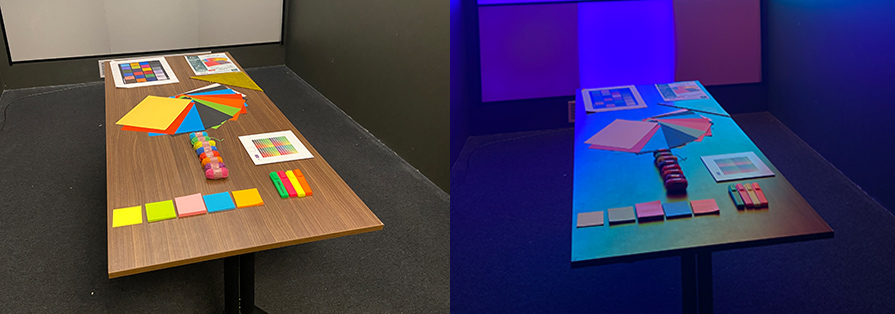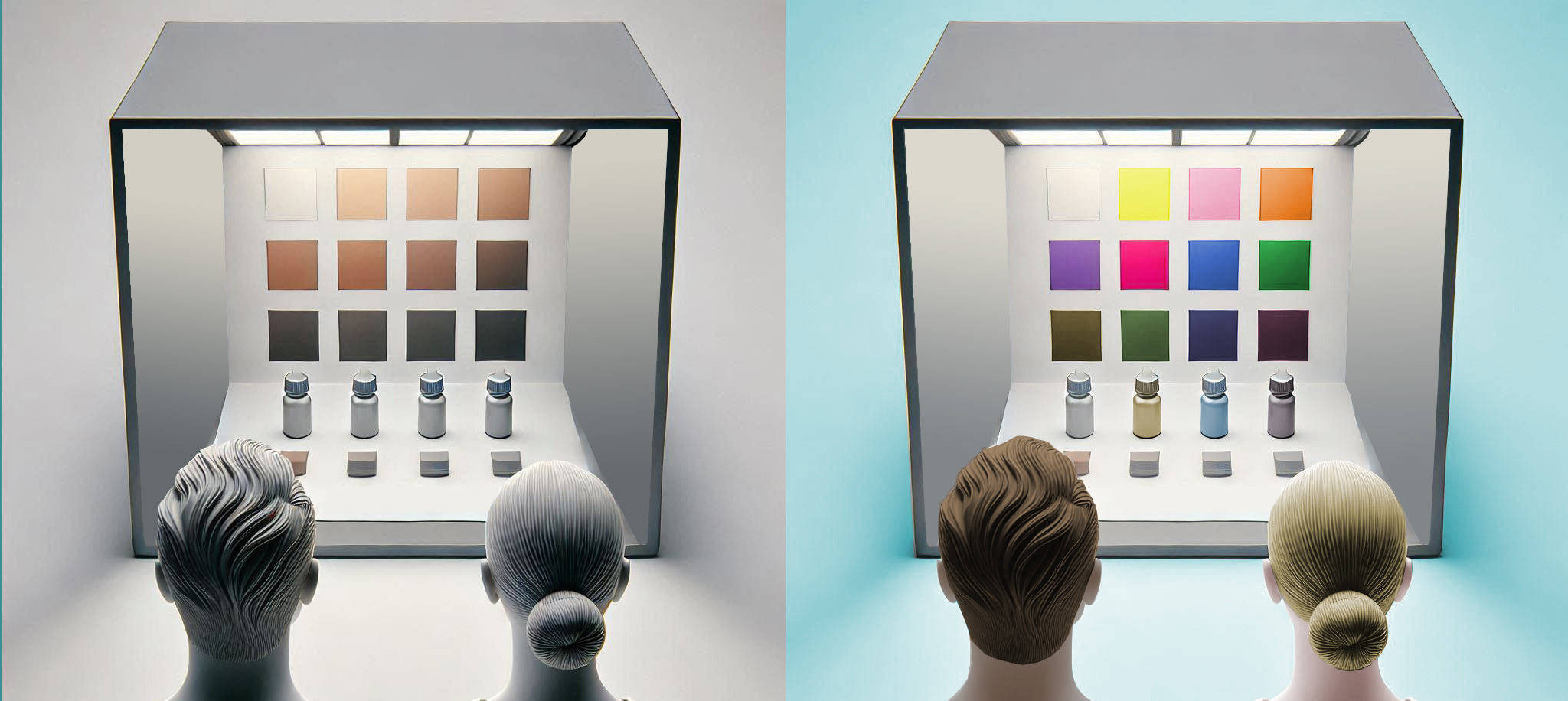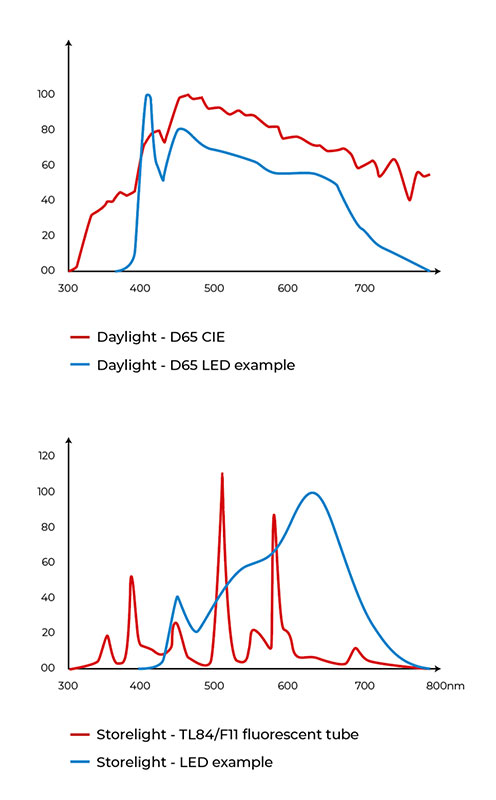Led & Perceived Quality
Design & visual control of perceived quality under LED Illuminants: discover COLOR THE LIFE’s subscription study to ensure design excellence and visual consistency in the LED era.
A new era in Perceived Quality
Transport, Domestic appliances, IT, Architecture, Decoration, Fashion, Sport, Packaging, Cosmetics, Luxury:
we are looking for brands, manufacturers and federations ready to join our ambitious project!

The Challenge
The transition from fluorescent to LED lighting has brought new challenges for industries relying on consistent visual standards.
– LED heterogeneity disrupts color and material perception.
– Current CIE standards need adaptation for LEDs.
– Metamerism, durability, and micro-defects become harder to assess under LED illuminants.
Our Solution
In partnership with the Laboratory of Sophie Jost at ENTPE and the Cluster Lumière, COLOR THE LIFE is conducting a multi-sector study to identify new standards D50 and D65 LED illuminants and define appropriate visual assessment protocols.
Our aim is to create a universal reference for designers, engineers and technicians of Colour and Perceived Quality and we will publish a White Paper aligned with the CIE, which will provide guidelines for the choice and use of LED illuminant in light booths, color management tools and store lighting.
Are you ready to define the common new standards for daylight D65 & D50 and the best store lighting standards for your company?

Phase 1: Spectroradiometric and photometric measurements of 10 light booths
Definition of the measurement protocol :
– Determination of the position and number of measurement points
– Spectral measurements using the SPECBOS 1211-UV spectroradiometer: determination of stabilisation time, verification of repeatability.
– Measurement of uniformity using a luxmeter on the horizontal surface or at a certain height depending on the size of the samples presented,
– Luminance mapping (with Photolux);
Measurement of 10 boxes, each with 4 lighting / D65 (with or without UV) and 2 shop lighting simulations: Calculation of colour rendering metrics, metamerism if necessary, evaluation of spectral difference.
Report writing: Measurement report, iso-luminance map, illuminance stabilisation curve, iso-luminance map.
Phase 2: Measurement of sample reflectances
Measurement of the spectral reflectance of the samples under diffuse conditions (45° to be as representative of the evaluation conditions):
– MacBeth chart and greyscale chart
– Two specific samples minimum per brand (to be provided in duplicate for visual assessment)
Phase 3: Visual assessment of the light booths
– Determination and implementation of the experimental protocol (pair, triad, ranking), randomisation, anonymisation, semantic analysis.
– Evaluation by the brands of the standard samples and their specific samples
– Analysis of results and correlation with measurements
Phase 4: Dissemination of results
– Drawing up specifications to define the most suitable standard illuminants for the samples tested (MacBeth Charter, Greyscale Charter and brand samples: plastic, paint, textile, etc.).
– Provision of the results of the study to the project stakeholders
– Writing a scientific article and presenting the results at a CIE conference
– Making available to the public the White Paper ‘Design & Visual Control of Perceived Quality under LED Illuminants’.
Benefits for Stakeholders
BRANDS & MANUFACTURERS
Ensure consistent perceived quality from design to retail thanks to new specifications for Daylight and Storelight illuminants.
LIGHT MANUFACTURERS
Gain insights to adapt to new standards.
CUSTOMERS
Experience improved product quality under LED lighting conditions.
RESEARCHERS
Contribute to industry-leading studies on color perception and standards.
Key Facts at a Glance
SUBSCRIPTION STUDY
You can participate in the full study or purchase the white paper only (early-bird discount).
WHITE PAPER CONTENT
– Common Standard Daylight illuminants that meet the needs of industry (design, development, production) : D50 and D65 with and without UV
– Analyse of illuminants for store lighting to define the appropriate standard for each context (3000 > 5000 K)
– Clear guidelines and proven protocols for the choice of LED illuminants and related tools in various industrial and commercial contexts
TIMELINE
– Pre-study carried out in France in 2024,
– Validation of participants, sample & light booth scope to be evaluated in March 2025,
– Evaluation of samples under light boxes in May 2025 (Cluster Lumière, Lyon, France),
– Results presented to participants in summer 2025,
– Presentation to CIE and release of White Paper in autumn 2025.
PLAYERS
Coordinator: COLOR THE LIFE
Consultant Laboratory: LTDS – UMR CNRS 5513 – ENTPE
10 brands/manufacturers : Transport, Industrial design, Architecture and decoration, Fashion, Luxury, Sport, Cosmetics
Light booth manufacturers
Why participate in the full study?
Are you uncompromising about the perceived quality of your materials or finished goods? Are your products manufactured in different locations or composed of multiple materials? LEDs are used in your design cells and perceived quality laboratories, or at your supplier/customer’ sites?
This subscription study is a unique opportunity to :
– test the visual control of your brand’s colors, materials and finishes under the majority of Led light booths on the market,
– define the common new standards for daylight D65 & D50 and the best store lighting standards for your company: specifications to be used for the renewal of your light booth fleet and store lights,
– take part in an innovative, collaborative project that unites the industry around common challenges and share your team experience with experts in color and perceived quality in today’s industry.
Participants will access to their own results, the global outputs and the White Paper.
Why purchase the White Paper?
So that you can apply the new daylight and store lighting standards and specifications resulting from the study to all your suppliers (light booths, color management solutions, lighting in your stores and products).
Early bird discount

